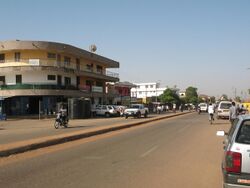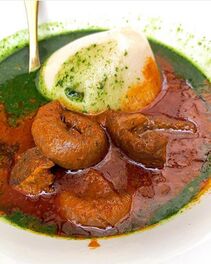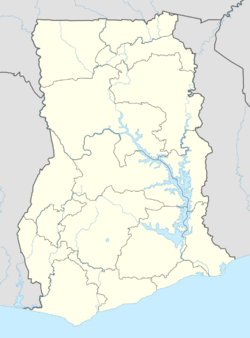Place:Wa, Ghana
Wa | |
|---|---|
Town | |
 View of a high street in Wa | |
| Coordinates: [ ⚑ ] 10°4′N 2°30′W / 10.067°N 2.5°W | |
| Country | Ghana |
| Region | Upper West Region |
| District | Wa Municipal District |
| Elevation | 305 m (1,001 ft) |
| Population (2012) | |
| • Total | 102,446[1] |
| Time zone | GMT |
| • Summer (DST) | GMT |
| Area code(s) | 039 |
Wa is the capital town of Wa Municipal and Upper West Region of northern Ghana.[2] It forms part of the eleven Municipalities and Districts that make-up the Upper West Region.[3] It’s Municipal Assembly is one of the 261 Metropolitan, Municipal and District Assemblies (MMDAs) in Ghana.[4]
According to the result of the 2021 population and housing census of the municipality indicated a total population of 200,672 with 98,493 males and 102,179 females. [5]Features in the town include several churches and mosques, the Wa-Na Palace, the St. Andrew's Catholic cathedral, the University for Development Studies (UDS), a museum, a nearby hippopotamus sanctuary in Wicheau (located in the Wa-West district), the mushroom rock in Jirapa and the ants hill at Nanvielle. The geography of Wa is notable for the dramatic monadnock Ombo Mountain, which is located around Kaleo and visible from much of the Wa town. Other notable towns around Wa region include Naaha and Ga.
The town is a transportation hub for the Upper West region, with major roads leading north to Hamile, and northeast to Tumu and the Upper East Region. There is also a small airport, named the Wa Airport.[6]
History
Wa has been inhabited for several hundred years by traders who settled in Wa to participate in the trans-Saharan trade. Wa also holds the mortal remains of Babatu, a notorious raider well known for his raids in the Upper West region during the late and early 19th century. Wa was the capital of the Kingdom of Wala.
In 1892, G. E. Ferguson, a Fante man who had explored the Asante Empire and areas to its north on the instructions of the governor of the Gold Coast Colony, reported that the population of Wa at the time was larger than that of Accra. Ferguson had not reached Wa in his travels, but had been to some towns under the control of Gonja.
In April 1897, a force of the Southern Nigeria Regiment under Henderson attempted to take Bouna, Ivory Coast from Samory Toure's Wassoulou Empire but were defeated at Dokita, then later routed and Henderson was captured at Wa.[7]:117-8
Starting in the 1930s the Ahmadiyya began to proselytise in Wa. This led to many clashes with the Sunni Muslims in the city, especially over use of the main mosque. In 1951 rioting rose to such a level that the Wala people considered it to have been a civil war.[8]
Violence broke out in 1978 between the Ahmadiyya and the Sunni. In 1980 there was intense fighting among the leaders J. N. Momori and Yakubu Seidu both mobilized their supporters, seeking to succeed Sidiki Bomi as the Wa Na. Momori eventually in 1985 became the Wa Na with the reign name of Wa Na Momori Bondiri II.[9]
Demographics
In 1880 it is estimated that Wa had about 8,000 people. This number is thought to have fallen to 2,000 by 1900. In 1921 the census found the population to be 2,806. The population had risen to 5,207 by 1931. In that year the Wa district of the Wala Native Authority had a population of 13,025. In 1948 Wa had a population of 5,128 while the district had 15,827 people. In 1960 the population was 14,406. In 1970 the population had risen to 21,393.[10]
In 1984 Wa had a population of 36,000. In 2012, it had a population settlement of 102,446.[11]
In the 1880s Wa was said to have a population that was entirely Muslim. The Ahmadiyya began gaining converts here in the 1930s. Recent estimates place the overall population of the Roman Catholic Diocese of Wa as about 5% Catholic, but how much this is in Wa and how much in other areas under the diocese is not clear. The Church of Jesus Christ of Latter-day Saints established a branch in Wa in mid-2017, making it so that every region in Ghana had at least one official congregation of the Church.
Transportation
There is public transport from Wa to major cities such as Accra; Kumasi, Mim, Ahafo; Cape Coast, Sunyani; Tamale; Tema; Ho; Bolgatanga; Elubo; Aflao, Techiman.
Environment and weather
Wa is in the southern part of the Sahel, the semi-arid area south of the Sahara with a landmass of approximately 1,078km², in between latitudes 9º 55”n and 10º 25”n and longitude 1º 10”w and 2º 5”w. It has a size that covers a total land area of 584 square kilometres. [12]
Average annual rainfall is around 879 millimetres (34.6 in), almost all of which occurs between May and October.
The municipal share surrounding borders with Wa West District to the west, Nadowli Kaleo District to the north, the east, with Wa East District , Sawla Tuna Kalba Districts to the south.
Following the May–October rainy season is a cool dry period called the Harmattan when a steady, often dusty, north wind blows from the Sahara. The hottest period of the year is in February and March when daytime temperatures often reach 40 °C (103 °F).
Script error: No such module "weather box".
Economy and agriculture
Despite its urban status, Wa is in many ways still an agricultural community, and the majority of the Wa population make a good portion of their living in small scale farming. The main crops are corn, millet, yams, okra and groundnuts. Upland rice is also farmed in a few areas of Wa. The major fruit crop is the mango. Shea nuts are collected from wild trees for food or refinement into oils and cosmetics.
Education
The biggest Senior High School in the Upper West Region is Wa Senior High School (formerly, WASSEC), can be found in the town. WASSEC had some tumultuous times in the past due to mismanagement and indiscipline which decreased the school's standards. However, the school has recently been recording major improvements in students' general discipline and performance in the West African Senior Secondary School Certificate Examination.[14]
Wa also has St. Francis Xavier Junior Seminary, built in the 1960s.
The University for Development Studies (UDS) is a major university in Ghana and one of its campuses is in Wa, with three faculties:[15]
- Integrated Development Studies
- Planning and Land Management
- Education, Law and Business Studies
Schools in Wa
- Islamic Senior High School
- Jamiat Al-Hidayyat Al-Islamiat Girls Senior High School
- Northern Star Senior High School
- St. Francis Xavier Minor Seminary
- Wa Senior High School
- Wa Senior High Technical School
- Wa Technical Institute
- T. I. Ahmadiyya Senior High School
- Nusrat Jahan College of Education
- Nursing Training college, Wa
- Wa Technical University (formally Wa Polytechnic)
Culture
The Damba Festival
The Damba festival was the main traditional event of Wa.[16] It was typically held in late September to correspond with a harvest in Wa. The highlight of the year was a ceremony in which the Wa-na stepped over a small cow lying on the ground. According to traditional belief, if any part of the Wa-na or the Wa-na clothing touched the cow, the Wa-na would probably die within the year. If on the other hand, the Wa-na stepped over the cow successfully, the Wa-na was guaranteed a successful coming year.

Food and cuisine
The staple food of Wa is known as sao or Tuo Zaafi in the local dialect, which is often abbreviated TZ or T-Zed in English. Tuo Zaafi means "very hot tuo" in Hausa. It is a thick porridge of corn flour eaten by tearing off a chunk and dipping into a soup, usually of okra.
Other foods common to the Waala people are Kapala (a widely consumed food in Ghana, more commonly known as Fufu), Kuon-tulu (literally translated as "hot water" in Waale, a breakfast food commonly known as Kooko or Hausa Kooko) and Kpogulo (beans powder made into paste, wrapped in Cocoyam or Taro leaves and served with a side of tomato stew).
References
- ↑ "World Gazetteer online". World-gazetteer.com. http://bevoelkerungsstatistik.de/wg.php?x=1170623253&men=gcis&lng=de&dat=32&geo=-85&srt=npan&col=aohdq&pt=c&va=x.
- ↑ "Campaign on effective handling of food items held in Wa" (in en-gb). https://www.graphic.com.gh/news/general-news/campaign-on-effective-handling-of-food-items-held-in-wa.html?template=graphictv&is_preview=on.
- ↑ "Wa Municipal". https://mofa.gov.gh/site/directorates/district-directorates/upper-west-region/278-wa-municipal.
- ↑ "Ghana Districts: A repository of all Local Assemblies in Ghana". https://www.ghanadistricts.com/Home/District/168.
- ↑ "Ghana Districts: A repository of all Local Assemblies in Ghana". https://www.ghanadistricts.com/Home/District/168.
- ↑ Touring Ghana – Upper West Region. touringghana.
- ↑ Fofana, Khalil (1998). L' Almami Samori Touré Empereur. Paris: Présence Africaine. https://archive.org/details/lalmamisamoritou00fofa/page/16/mode/2up. Retrieved 30 September 2023.
- ↑ Ivor Wilks, Wa and the Wala: Islam and polity in northwestern Ghana (Cambridge: Cambridge University Press, 1988), p. 1-2
- ↑ Wilks, Wa and the Wala, p. 2-3
- ↑ Ivor Wilks, Wa and the Wala: Islam and polity in northwestern Ghana (Cambridge: Cambridge University Press, 1988), p. 11-13
- ↑ Ofori, Peres. "Sustainable Environmental Sanitation:the role of waste disposal facilities in a nucleated settlement-a case of Wa Municipality". Academia. https://www.academia.edu/26084660.
- ↑ "Road disrepair and road density by province". 2016-10-24. doi:10.1787/eco_surveys-idn-2016-graph35-en. http://dx.doi.org/10.1787/eco_surveys-idn-2016-graph35-en.
- ↑ "Klimatafel von Wa / Ghana" (in de). Baseline climate means (1961-1990) from stations all over the world. Deutscher Wetterdienst. http://www.dwd.de/DWD/klima/beratung/ak/ak_654040_kt.pdf.
- ↑ "Secondary Education in Wa". ModernGhana.. 31 December 2013. http://www.modernghana.com/news/92674/1/wa-secondary-school-for-the-first-time-records-100.html.
- ↑ "Wa Campus". Uds Ghana. 23 June 2013. http://www.uds.edu.gh/wa.
- ↑ "Damba as a festival and dance form" (in en-US). 2014-07-11. http://artsghana.org/damba-as-a-festival-and-dance-form/.
External links
[ ⚑ ] 10°04′N 02°30′W / 10.067°N 2.5°W
 |


